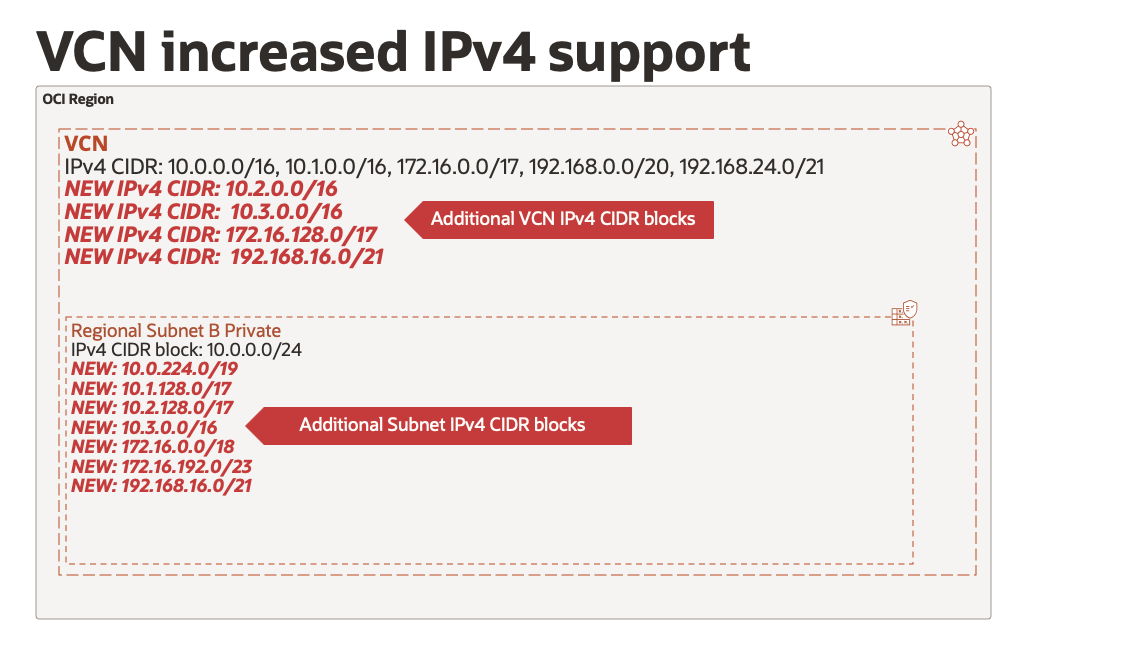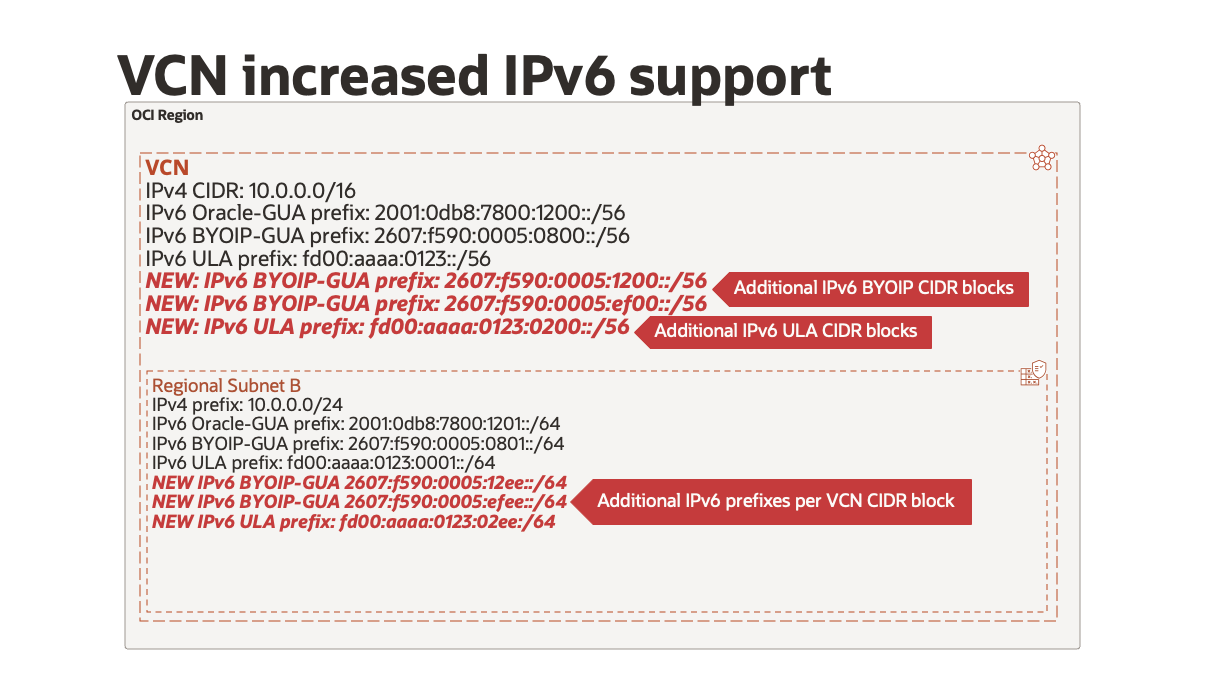Oracle Cloud Infrastructure (OCI) is pleased to announce increased IP network limits for Virtual Cloud Network (VCN) CIDR blocks and subnets in all commercial regions. With the recent launch of IP CIDR addressing, IP consumption is growing exponentially. This feature lets you enhance a subnet with up to 16 IPv4 and 16 IPv6 networks with no constraints on primary or secondary IP address assignment. This is a 15-fold increase for IPv4 and 3-fold increase for IPv6. Additionally, you can also assign up to 16 IPv4 CIDR blocks and 16 IPv6 prefixes to a VCN for additional address capacity. Overall, this enhancement delivers:
- More than one IPv4 CIDR block for each subnet
- More IP networks for use within a VCN and within each subnet
- Simplified compute instance configurations with VNIC consolidation
- Scaling beyond 100% IP utilization of a subnet
- Flexibility of primary IP and secondary IP object assignment, to include IP CIDR addresses, across any subnet CIDR block or prefix
VCN and Subnet IPv4 support
To assign IPs to your applications, an OCI VCN is required, along with a subnet. OCI now supports up to 16 non-contiguous IPv4 CIDR blocks for a single subnet. You can use any of the subnet’s networks for your IP address assignment.
To provision the VCN itself, one IPv4 CIDR block is required for private IP addressing. Today, we are excited to offer you up to 16 IPv4 CIDR blocks per VCN. Increasing this limit allows for large scale, diverse network addressing for a single VCN design.

Figure 1. VCN and Subnet IPv4 increases
VCN and Subnet IPv6 support
In 2022, OCI announced VCN IPv6 support for three categories of prefixes including increased limits so you can use them all concurrently in a single subnet:
- Oracle-global unicast addresses (GUA)
- BringYourOwnIPv6-GUA (BYOIPv6)
- unique local addresses (ULA) along with support for up to five VCN IPv6 prefixes.
Today we are excited to share that you can add up to 16 prefixes to a VCN subnet. A subnet can include any mix of up to 1 Oracle-GUA, 16 BYOIPv6-GUAs, and 16 ULA prefixes.

Figure 2. VCN and Subnet IPv6 increases
Benefits
Increased address availability
To expand available addressing as IP utilization increases, you can add more CIDR blocks to the subnet. You no longer need to provision more subnets and modify your infrastructure as code (IaC) to include the logic for selecting the most appropriate subnet based on IP availability; OCI will automatically assign from a single subnet with multiple prefixes on your behalf. This frees you to launch virtual network interface cards (VNIC) from any of the subnet’s CIDR blocks, not limiting you to just one.
Reduced VNIC complexities
Previously, to assign IPv4 addresses from disparate networks for a compute instance, two or more VNICs were required. Virtualization systems like Kubernetes and hypervisors can now consolidate multiple VNICs and eliminate complex host-based routing through using a single VNIC. You no longer need to ensure a minimum number of OCPUs for proportional VNIC attachments; OCI will allow you to assign 65 IPv4 objects across 16 different CIDR blocks for a single VNIC.
Hybrid and multicloud support
Whether you plan to migrate workloads to OCI or use OCI as part of a disaster recovery plan, you no longer need to rearchitect your systems that need multiple non-contiguous IP networks. You can deploy smaller IP networks to existing subnets when needed and then move the entire CIDR block or prefix once migrations have completed. This lets you easily reuse legacy, on-premises IP space in OCI without creating more VCNs or subnets.
Conclusion
These limit increases provide you flexibility in how to assign IP networks and addresses to your systems. To get started, just add more VCN or subnet networks through the Console or programmatically through the OCI CLI, SDKs, and Terraform provider.
To learn more about OCI Virtual Networking, please review the following resources:
